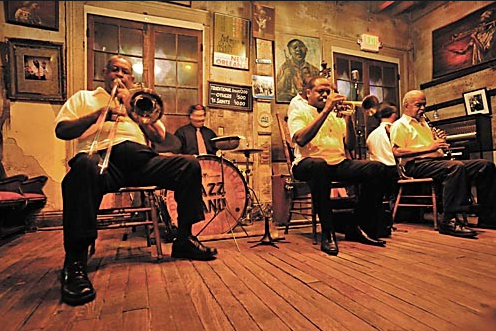Include a Topper!
-
Happy Birthday Banner
$9.00 -
Gingerbread Cake Topper
$15.00
Add Ons
Your cart is currently empty!
Since 1949 celebrating 75 years. Order online or call us at 1 800 GAMBINO (426-2466)

In a city whose culture is founded on art and music, nothing represents the collision of these two worlds better than Preservation Hall. It has a history that epitomizes New Orleans’ zest for community and collaboration and continues to embody that spirit to this day.
A Jazz Hall by Any Other Name
While it is now known as the Big Easy’s premiere, though intimate, jazz concert venue, Preservation Hall wasn’t always the renowned gem it is today. In fact, its beginnings had nothing to do with jazz at all. In the early to mid 1950s, New Orleans native Larry Borenstein opened an art gallery on St. Peters Street in the heart of the French Quarter, sidled between Bourbon and Royal. While Mr. Borenstein loved his art gallery, he felt like it was compromising his love for something else: jazz music. Because he spent so many evenings running the gallery he was inhibited from attending local jazz concerts as often as he was used to.
Not one to sacrifice his love for local music, Mr. Borenstein concocted a plan. He began to offer up the gallery as a rehearsal space for jazz musicians. Not only did this remedy his desire to hear more music, but it enhanced the gallery’s ambiance. Art enthusiasts from around the city could now enjoy New Orleans’ musical flavor while they perused its artistic offerings. Mr. Borenstein’s wee little art gallery began to host some of the Big Easy’s biggest jazz names, people like Punch Miller, Sweet Emma Barrett, and the Humphrey Brothers (just a select few names from a vast list of talents). It didn’t take long for the music to overshadow the art; “Mr. Larry’s Gallery”, as it was known, quickly became known for who was playing rather than who was painting there.
A Smooth (Jazz) Transition
In 1960, two tourists came to our sweet city and set in motion the transformation that would bring Preservation Hall truly to life. Allan and Sandra Jaffe took a hiatus from their life in Pennsylvania and came to New Orleans to celebrate their newly minted marriage. While perhaps a strange honeymoon spot to some, the Crescent City had the ultimate lure for the Jaffes: jazz music (a common theme in this story). Having heard of “Mr. Larry’s Gallery” from fellow jazz aficionados, the Jaffes made a visit to his space priority on their to-do list.
Like so many others, they fell in love with the jazz culture and music of Mr. Borenstein’s gallery. They just couldn’t tear themselves away from the foot tapping beats and joyful dispositions, so they returned home to Pennsylvania to pack their things up and moved to New Orleans. They frequented “Mr. Larry’s Gallery” until 1961, when change shook the foundations. Mr. Borenstein moved the art gallery to an open space right next door and transformed the original space into the permanent music venue that it had become. He named it “The New Orleans Society for the Preservation of Traditional Jazz” and had musicians play for donations, considering the venue a non-profit focused on reviving New Orleans jazz culture.
While it was a thoughtful idea, its success wasn’t originally apparent and the Jaffes, in collaboration with Mr. Borenstein, took over operations and transitioned the venue into a profit and loss business. It is at this point, in 1961, that Preservation Hall was officially born, although its true history dates back almost a decade before that.
The Who and the What
Under the Jaffes’ tutelage, Preservation Hall blossomed. It became much more than a music venue. Today when we speak of Preservation Hall, we may be talking about the actual venue, but we may also be talking about their personal jazz band, or even their non-profit organization.
The Preservation Hall Jazz Band was formed by a couple of local musicians who played the venue regularly. In 1963, with Allan’s suggestion, they actually began touring, taking the history and culture of New Orleans jazz not only around the country, but around the world. Over the past 5 decades they have not only performed internationally, but have toured with bands as prevalent as the Grateful Dead. Their members have changed over time, but the Preservation Hall Jazz Band boasts several albums and represents a name known far and wide. Today the band is made up of Charlie Gabriel on sax and clarinet, Clint Maedgen on sax, Ronell Johnson on trombone, Walter Harris on drums, Kyle Roussel on piano, Branden Lewis on trumpet, and a very special last member… Ben Jaffe, the son of Allan and Sandra and current operator of Preservation Hall, on bass and tuba.
The Preservation Hall Foundation is a non-profit that embodies Mr. Borenstein’s original intentions. It seeks to “protect, preserve, and perpetuate the musical traditions and heritage of New Orleans” through “music education, outreach, historical archiving, and support for [their] musical collective” (quoted from their website). And while the venue is an incredible piece of New Orleans culture, it is perhaps the Foundation’s mission that represents the true importance of this story. In the 1950s, when Mr. Borenstein’s plight first began, jazz was in large part being overshadowed by rock and roll and despite the Jazz Revival in the 1940s, jazz venues were incredibly scarce, even in our bright sax-y city. Preservation Hall’s creation and success has been the pinnacle of revived jazz culture, not only in our city, but across the country. We must look to the venue for its proliferation of talent, but we must thank the Foundation for upholding the musical tradition that makes our city special.